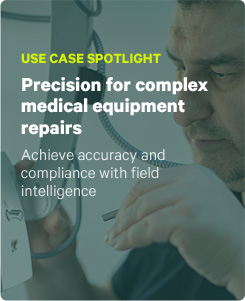At a glance:
- Visibility gaps hamper field service: AI and machine learning are transforming the field service industry. Successful field service tech adoption of these technologies is crucial for staying competitive.
- Technicians face delays and customer frustration: Only 10% of executives see substantial gains from AI/ML. Successful deployment requires more than just technology investment.
- Tech tools boost first-time fix rates: True tech adoption transcends mere deployment, demanding a cultural shift towards data reliance and innovation. Transformational leadership bridges the gap between technician experience and company goals.
The field service industry is undergoing a rapid transformation. Leaders increasingly turn to technologies like Artificial Intelligence (AI) and Machine Learning (ML) to streamline operations, optimize decision-making, and gain a competitive edge. For example, Shell collaborates with SparkCognition to speed up exploration using generative AI. Meanwhile, Johnson Controls leverages ML to optimize building environments, focusing on systems that learn and improve autonomously to enhance operational efficiency.
Even though these projects can bring significant benefits, they are far from a universal remedy. A survey of 3,000 executives revealed that only 10% reported substantial financial outcomes from their AI/ML initiatives. To function correctly, these technologies need good data, and as such, leaders must be prepared to fully govern their data environment and ask questions about quality, accessibility, and integration. This is just one of the many typical examples of technology investments not being the sole predictor of business outcomes. As many executives are discovering, buying digital tools is no longer enough to move the needle as much as any competitive organization needs to.
As Chief Field Service Officer (Technology & Operations), Jennifer is deeply involved in integrating innovative technologies into her company’s operations… Her focus is on successful field service tech adoption, ensuring the tools are not just present, but truly utilized. Her role involves supervising implementation, handling supply chain challenges, and minimizing the learning curve for new tools. At a meeting, Jennifer hears about decreased service quality at a customer location. Suspecting her company’s recently upgraded field service management (FSM) system, she investigates. The culprit? Not the technology itself but a lack of utilization by field technicians. This reveals a critical gap between the system’s potential and actual use.
Tech integration for field service success
Jennifer’s experience is not unique. According to McKinsey, the mark of true field service tech adoption success lies not in deploying new technologies but in a cultural shift towards data reliance and the spirit of innovation.
“True tech adoption transcends mere deployment, demanding a cultural evolution towards data reliance and innovation, where leaders must tailor tools to empower technicians, turning service efficiency into strategic success.”
Transformational leadership bridges the gap between technician experience and company goals, not through coddling but by fostering a collaborative environment. Skilled technicians are resourceful problem-solvers who often devise creative workarounds to improve efficiency. However, these solutions may not always align with the organization’s objectives. The answer lies in a culture of mutual respect and exchange. Leaders can actively invite technician input and understand the challenges they face. By acknowledging the value of their on-the-ground experience, companies can leverage technician insights to:
- Identify areas for improvement: Technicians are at the forefront of service delivery and can pinpoint inefficiencies in workflows or limitations of existing technology.
- Refine technology implementation: Technician feedback can guide the development and optimization of new tools, ensuring they address real-world needs and workflows.
- Align individual contributions with company goals: By integrating technician solutions into the broader strategy, companies can leverage their ingenuity while ensuring alignment with organizational objectives.
This collaborative approach fosters a sense of ownership and empowers technicians to contribute to their company’s success. They are no longer passive recipients of technology but valued partners in driving innovation and achieving strategic goals.
Streamlining field service with smart tech integration
Jennifer first looks for the root cause of the decline in service quality, employing a multi-pronged plan to gain a comprehensive understanding of the situation. She dives into service reports, analyzing trends and patterns in response times, error rates, and technician feedback associated with the new system compared to historical data. She also recognizes the importance of the technicians’ perspective and works to establish a Technician Advisory Council, which gathers ongoing feedback and informs future technology decisions. These in-depth interviews are conducted with a representative sample of technicians from various regions and different experience levels.
As she analyzes data and listens to interviews, Jennifer identifies two significant issues. Firstly, her technicians’ mobile app in the field is too complicated, causing delays in response times and errors in data input when they revert to paper forms. Secondly, a lack of real-time data integration affects the effectiveness of reporting tools and impacts the quality of service provided. At one session, a senior technician speaks up about his prior experience with a field service app platform with a user-friendly interface and robust integration capabilities to address the challenges faced. Jennifer sees this as the ideal solution to prioritize technician adoption and seamless process integration for success.
User-centric technology adoption in field service tech adoption
Armed with feedback from the Technician Advisory Council, Jennifer tackles the two main challenges that were hindering user adoption:
- User interface complexity: The technicians’ mobile app was replaced with a more user-friendly platform.
- Real-time data integration: Jennifer solves the lack of real-time data integration with a new system that supports more integrations and rapid workflow iteration.
The initial results are promising. Technicians across the board report a significant improvement in the user experience with the new app. The intuitive, streamlined interface minimizes training time, reduces errors, and allows them to focus on their core tasks. Additionally, real-time data access empowers technicians to solve problems more efficiently and deliver exceptional service. They now have up-to-date information on customer sites, inventory, and job requirements, leading to better on-site decision-making, improved service quality, and faster issue resolution.
A collaborative path forward
Jennifer’s focus on user experience and collaboration has paid off. Early metrics indicate a noticeable improvement in data accuracy and a slight reduction in response times. These trends are expected to continue as technicians become even more comfortable with the new system and its capabilities. Looking ahead, Jennifer plans to leverage real-time data insights to optimize the system further and explore advanced features like AI-powered diagnostics. This will empower technicians even more by providing them with predictive maintenance capabilities and troubleshooting assistance, allowing them to anticipate potential problems and resolve them before they escalate.
By prioritizing user feedback and a user-centric approach, Jennifer has not only bridged the gap between the FSM system’s potential and its actual use but also fostered a more collaborative and empowered work environment for her technicians. This approach sets the stage for continued improvement and innovation within her organization.
Building a culture of user-centric innovation
Jennifer’s experience highlights the significance of adopting a user-centric approach in field service technology. Simply deploying new tools is not enough. To ensure success, leaders must prioritize user experience, actively seek technician input, and customize technology to address their practical requirements. By fostering a collaborative environment that values technician expertise, companies can bridge the gap between technology’s potential and its practical application.
The road to successful user adoption: a continuous journey
Remember, successful user adoption is an ongoing process. Here are some key questions to consider as you implement new technologies:
- Has my field team fully adopted our processes and tools?
- Are there barriers that they are working around that we are not aware of?
- How do I better anticipate adoption roadblocks?
By actively seeking feedback from your technicians and fostering a culture of open communication, you can continuously iterate and optimize your approach. Ready to unlock the full potential of user-centric technology adoption in your field service operations? Speak to one of our product experts today to discuss how our solutions can empower your technicians and transform your business.




